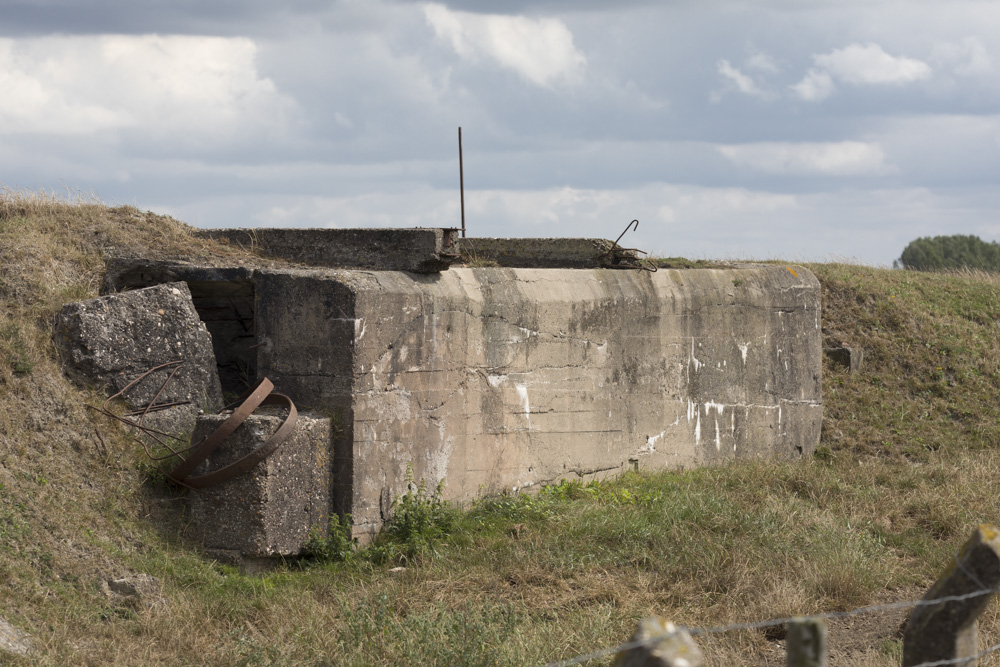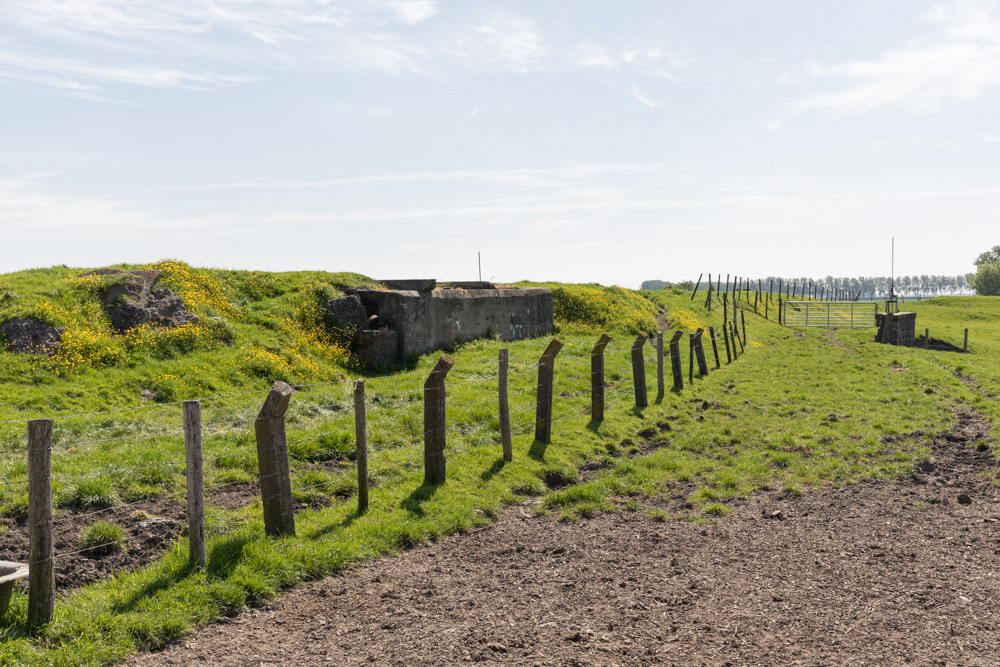Hollandstellung - Personnel Bunker Type L Nieuwe Hazegrassluis
Hollandstellung
The Hollandstellung, also known as the "Holland Line", was a German defence line constructed during the First World War, stretching over a distance of approximately 65.5 kilometres, from the Belgian coast at Knokke to Vrasene, and further connected to fortified positions around Antwerp (Stellung Antwerpen) and the Turnhoutkanalstellung on the east side. The line was mainly built between 1916 and 1918 and was intended to provide protection against an expected Allied invasion from neutral Netherlands. This area was seen by the German army leadership as a vulnerable flank.
The Hollandstellung was built by the German navy (Marinekorps Flandern) and army (Etappen-Inspektion 4 / Gruppe Gent). The navy sector was located between the Zwin (Knokke) and Leeskensburggen. The army sector started from Moerhuize (Maldegem). The area around Strobrugge formed a transitional area. The naval bunkers were generally made of reinforced concrete, while the army bunkers were mainly made of prefabricated concrete blocks.
The line was divided into a Vorstellung and a Hauptstellung. The Vorstellung had the task of holding off the enemy for as long as possible. The Hauptstellung formed the backbone of the Hollandstellung and consisted of strong fortifications. Various areas were designated as Sumpfgebiete; areas that could be made marshy.
Despite the extensive fortifications, the Hollandstellung saw limited action during the First World War, because the main front lines were further south and east. By the end of the First World War, a total of 411 bunkers had been built. The most westerly bunkers and those in the Maldegem sector were added to the Atlantic Wall during the Second World War. In October 1944, the Allies launched Operation Switchback. The former Hollandstellung bunkers in the Maldegem sector were located in an area where heavy fighting took place.
Today, many of the remains of the Hollandstellung can still be found in the landscape. The Hollandstellung is included in its entirety in the list of immovable heritage of Flanders. Many bunkers have been demolished in the past. The website bunkergordel.be inventories these disappeared bunkers.
Personnel Bunker
The main task of a personnel bunker was to provide protection for a group of soldiers. The personnel bunkers of the Hollandstellung were armed with one or more machine guns that were positioned in the open air, usually shielded by a concrete wall or parapet. These bunkers could also be used for observation purposes. Many of these bunkers were camouflaged. In post-war Belgian inventories, the bunkers were classified with letter codes. Although most bunkers show similarities with the original construction plans, there are still many variations. We have grouped these variations under one and the same type.
The bunker was part of Stutzpunkt Heinrich, which was built on the remains of the Belgian Leopoldfort. Stutzpunkt Heinrich consisted of about 20 bunkers and two 5cm guns. The complex was added to the Atlantic Wall in 1941 and further expanded with new bunkers.
This type of bunker is designated as type E in a post-war Belgian inventory, but is officially known as Mannschafts Eisenbeton Unterstand.
This (often semi-underground) bunker was built by the German navy from concrete. The bunker has one living space of approximately 4.8 by 3.5 meters and an L-shaped entrance on either side. In two remaining examples, there is a third entrance in the southwestern wall, which was used as an emergency exit. The bunker has one or more battle positions nearby consisting of concrete walls and posts. The bunker has internal defense in the form of a shooting hole at the entrance. Sometimes concrete blast walls are placed opposite the entrances. Some bunkers of this type also have concrete protrusions on the roof, used to place a thatched roof for camouflage. The surface area of this type of bunker varies from 207m² to 588m².
Special features
The bunker shows battle traces in the left access axis, possibly from machine gun hits. The bunker seems to have been modified during the Second World War. To what extent is not exactly possible to determine.
Do you have more information about this location? Inform us!
Source
- Text: TracesofWar
- Photos: Arjan Vrieze
- bunkergordel.be
-
Site Oud Fort Isabella en Nieuw Hazegrasfort | Inventaris Onroerend Erfgoed
Nearby
Point of interest
- Information Sign The Death Thread Is Alive - Cadzand Bad
- Information Sign Mine Field 114 Odette 712 - Knokke-Heist
- Former Airfield Knokke-Le Zoute (Advanced Landing Ground B-83) - Knokke-Heist
Monument
- Marker No. 14 Canadian Liberation Route - Knokke-Heist
- Vector of Memory: Bridge to the final opposition in Knokke - Retranchement
- Hickman Memorial Retranchement - Retranchement
Cemetery
- Commonwealth War Graves Cadzand - Cadzand
- Belgian Graves Veterans Knokke - Knokke (Knokke-Heist)
- Belgian War Graves Knokke - Knokke (Knokke-Heist)
Fortification
- Hollandstellung - Personnel Bunker 'Sitzbunker' Nieuwe Hazegrassluis - Knokke-Heist
- Hollandstellung - Personnel Bunker 'Sitzbunker' Nieuwe Hazegrassluis - Knokke-Heist
- Stützpunkt Heinrich - MG Wall - Knokke-Heist





